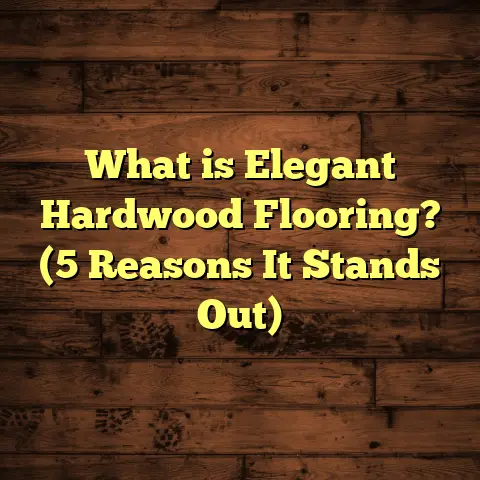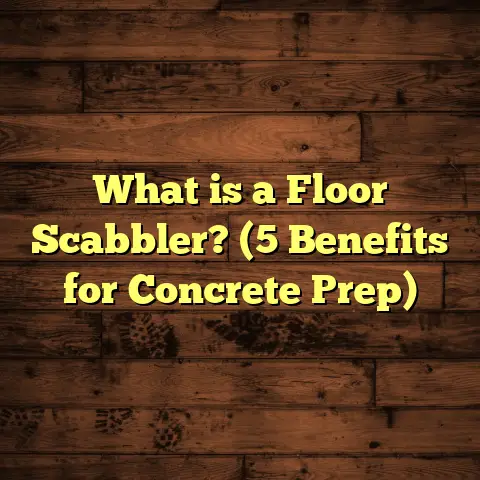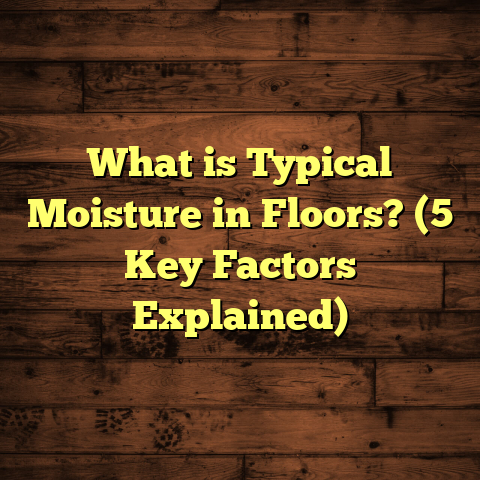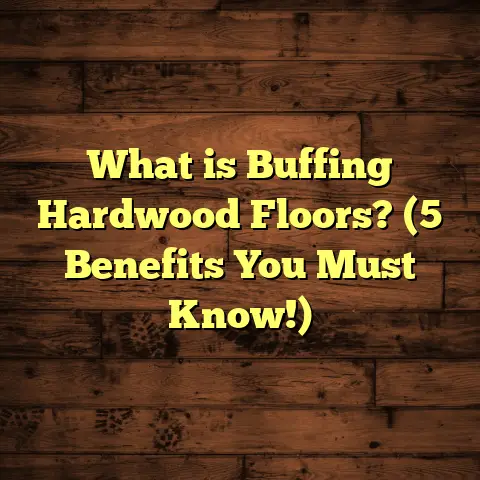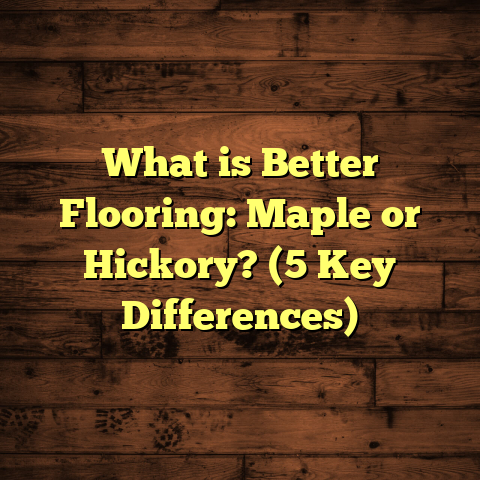What is Free Floating LVT Flooring? (5 Benefits for Luxury Spaces)
When I first got into flooring, one thing became clear right away: the flooring you choose can seriously affect the vibe of a space without emptying your wallet. I’m talking about value for money — getting something that looks great, lasts long, and feels comfortable underfoot without costing a fortune. Free floating LVT flooring fits this bill perfectly for many luxury spaces I’ve worked on. If you haven’t heard of it or want to know why it’s becoming so popular, I’d love to share what I know about free floating LVT and why it’s a fantastic option for high-end interiors.
What is Free Floating LVT Flooring?
Let’s start with the basics. What exactly is free floating LVT flooring? The term “free floating” refers to the method of installation where planks or tiles are not glued or nailed down to the subfloor. Instead, they are laid over the existing floor and held together by a locking mechanism — usually a click-lock system — that makes the floor “float” above the surface. Because it’s not fixed in place, it can expand and contract a bit without causing damage or warping.
Now, LVT stands for Luxury Vinyl Tile. It’s a type of vinyl flooring designed to mimic natural materials like hardwood, stone, or ceramic tile but with greater durability and easier maintenance. Unlike traditional vinyl sheets that come in rolls, LVT consists of individual planks or tiles that fit together.
LVT is made up of multiple layers carefully engineered during manufacturing:
- Backing Layer: This provides stability and moisture resistance from underneath.
- Core Layer: Usually composed of rigid or flexible vinyl. Some cores use composite materials like SPC (Stone Plastic Composite) or WPC (Wood Plastic Composite), which offer enhanced stability and durability.
- Printed Design Layer: This is where the magic happens. High-resolution photographic printing technology reproduces realistic textures and patterns such as wood grain or marble veining.
- Wear Layer: A transparent top coat that protects the design from scratches, stains, and fading.
The manufacturing process involves layering these components and bonding them under heat and pressure to create a tough, flexible product.
Free floating LVT utilizes a click-lock edge profile on the planks or tiles. When installed, these edges snap tightly together, creating a seamless surface that behaves like one continuous floor but isn’t glued down. This method is popular because it reduces installation time and makes replacement or repairs easier.
Technical Specs That Matter
Here’s a quick rundown of some specs that I always check before recommending free floating LVT:
- Thickness: Typically ranges from 4mm to 8mm. Thicker planks provide better comfort and sound insulation.
- Wear Layer Thickness: Usually between 6 mil (0.15 mm) and 20 mil (0.5 mm). For luxury spaces that see heavy foot traffic, I recommend at least 12 mil.
- Core Type: SPC cores are denser and more rigid than WPC or flexible vinyl cores. They resist dents and provide stability in large areas.
- Dimensions: Planks commonly measure 7 x 48 inches to mimic hardwood; tiles can be 12 x 24 inches or larger to imitate stone.
- Water Resistance: Most free floating LVT floors are waterproof or highly water-resistant.
- Underlayment: Attached underlayments improve sound absorption and add cushioning.
Manufacturing Insights
Digital printing technology has revolutionized LVT production. Instead of simple color layers, manufacturers use ultra-high-definition photographic images combined with embossing techniques to recreate natural textures. This embossing adds depth and tactile realism — you can feel the grain of the wood or the roughness of stone underfoot.
During production, layers are bonded using specialized adhesives under heat and pressure to ensure durability without sacrificing flexibility. The core layer’s composition varies by product but is critical for performance characteristics like waterproofing, stability, and impact resistance.
I’ve tested many brands over the years, both in residential and commercial spaces. The best products use SPC cores with thick wear layers and realistic embossing — these stand up to wear while looking incredible.
My Journey With Free Floating LVT Flooring
I remember one luxury penthouse project where the client wanted the warmth and elegance of hardwood but needed something more durable for their active family life with pets and kids. We chose a free floating LVT with an SPC core that replicated white oak beautifully.
Installation was quick — no messy glue, no subfloor prep beyond cleaning. The client was thrilled they could walk on the floor within hours instead of days. Over time, the floor held up perfectly despite scratches from pet claws and spills from daily life.
Another project was a boutique hotel lobby needing the look of marble but with better slip resistance and easier maintenance. We installed large-format free floating LVT tiles with an embossed marble design. The guests loved the aesthetic, and the hotel saved thousands compared to real stone installation costs.
These experiences taught me that free floating LVT isn’t just a budget alternative; it can enhance luxury spaces in ways other materials struggle with.
5 Benefits of Free Floating LVT Flooring for Luxury Spaces
Let’s chat about why free floating LVT works so well in upscale environments.
1. Luxury Style Without the Price Tag
When people think “luxury flooring,” they usually imagine hardwood or natural stone — both stunning but pricey. Hardwood might cost $8-$14 per square foot installed; natural stone can be even more expensive due to material and labor costs.
Free floating LVT offers similar aesthetics for $3-$7 per square foot installed. That’s a huge saving without sacrificing style.
You get realistic textures and colors that replicate expensive materials so closely many guests don’t realize it’s vinyl until they look closely.
For example, one client chose free floating LVT with a hand-scraped wood look for their upscale restaurant dining area. It gave them exactly the ambiance they wanted without blowing their renovation budget.
2. Fast and Easy Installation Saves Time
Time equals money in any renovation project. Free floating LVT installs significantly faster than glued-down vinyl, hardwood, or tile floors because you skip messy adhesives or grout.
The click-lock system snaps together quickly over most existing floors — hardwood, concrete, tile — without extensive prep work.
In one luxury condo renovation I did, we replaced dated carpet with free floating LVT in three bedrooms plus living areas in just two days total. The client appreciated how little disruption there was.
This speed is especially valuable for commercial projects needing fast turnaround like boutiques or office spaces aiming to reopen quickly.
3. Durability for High Traffic Areas
Luxury spaces don’t mean gentle use. Hotel lobbies, upscale retail shops, and busy residential homes experience heavy foot traffic daily.
Free floating LVT with thick wear layers resists scratches from heels or furniture legs better than laminate or traditional vinyl.
SPC core products add rigidity preventing dents or warping under heavy loads.
I once visited a large casino floor covered with SPC free floating LVT installed five years prior—it looked fantastic with no visible damage despite massive foot traffic.
4. Water Resistance Means Less Worry
I’ve seen too many hardwood floors ruined by water spills or humidity fluctuations. Free floating LVT is waterproof or highly water-resistant depending on product specs.
This makes it perfect for kitchens, bathrooms, basements, and even entryways in luxury homes.
In one waterfront property I worked on last year, free floating LVT held up great despite occasional wet shoes tracked inside during rainy season—no swelling or warping occurred.
5. Comfort and Sound Control
You might think vinyl floors are hard and cold; free floating LVT actually offers more comfort than glued vinyl or tile because it isn’t rigidly fixed to the subfloor.
Many products come with attached underlayment layers that cushion steps and reduce noise transmission—a feature appreciated in multi-story apartments or hotels where sound control matters.
I installed free floating LVT in a luxury apartment complex with radiant floor heating recently. The floor was warm underfoot yet durable and quiet — a win-win combination.
Backed By Data: What Studies Show About LVT Performance
Here are some numbers from recent industry research:
- According to a 2023 report by Floor Covering Weekly, North American LVT sales have grown over 12% annually for five years straight due to its versatility.
- Laboratory tests rate premium LVT wear layers at 4-5 on the Mohs hardness scale (similar to quartz), showing strong scratch resistance.
- Water absorption tests record less than 0.01% absorption rate for SPC cores—effectively waterproof.
- Thermal conductivity values around 0.17 W/mK make it compatible with radiant heating systems.
- A case study from a Chicago apartment complex replacing carpet with SPC free floating LVT reported a 40% reduction in yearly maintenance costs.
- Customer satisfaction surveys from retail stores show a 30% increase linked directly to improved flooring aesthetics and easier cleaning after switching to LVT.
This data aligns with what I’ve seen firsthand—free floating LVT combines beauty with performance in ways few other materials do at this price point.
Comparing Free Floating LVT With Other Flooring Options
Choosing flooring always means weighing pros and cons against your project needs:
| Flooring Type | Cost per Sq Ft Installed | Durability | Water Resistance | Maintenance | Installation Complexity | Comfort |
|---|---|---|---|---|---|---|
| Hardwood | $8 – $14 | Moderate | Poor | Needs refinishing | Moderate to High | High |
| Laminate | $3 – $7 | Moderate | Poor | Moderate | Easy | Medium |
| Glued Vinyl Sheet | $2 – $5 | Moderate | Moderate | Easy | Moderate | Low |
| Glued Vinyl Tile | $3 – $8 | Moderate | Moderate | Easy | Moderate | Low |
| Free Floating LVT | $3 – $7 | High | High | Very Easy | Easy | High |
| Natural Stone Tile | $10 – $20 | Very High | High | Moderate | High | Low |
From my experience:
- Hardwood looks beautiful but demands upkeep.
- Laminate is affordable but less water-resistant.
- Glued vinyl can be tricky to repair if damaged.
- Free floating LVT hits well-rounded marks on durability, ease, water resistance, style, and comfort.
- Stone is durable but expensive and cold underfoot.
Detailed Installation Insights: How I Approach Free Floating LVT Projects
Installation quality makes or breaks any flooring job. Here’s how I handle my projects:
Subfloor Preparation
The key to success is starting with a clean, flat subfloor. Although free floating floors tolerate minor imperfections better than glued ones, dips or bumps over 3/16 inch per 10 feet should be leveled out.
I inspect for moisture levels especially on concrete slabs because high moisture can cause issues even with water-resistant floors if not addressed properly.
Acclimation
I let the flooring acclimate at room temperature for at least 48 hours before installing. This reduces tension caused by temperature or humidity differences once installed.
Locking System Assembly
Most free floating LVT planks use click-lock profiles where edges snap together easily. I ensure tight joins without gaps by using spacers along walls to leave expansion gaps (usually about 1/4 inch).
Transition Strips & Finishing Touches
Proper transition strips between different flooring types prevent trip hazards and cover expansion gaps near doorways or stairs.
I recommend coordinating baseboards or quarter-round moldings to hide edges neatly while allowing floor movement.
Clean-Up & Maintenance Guidance
After installation, I clean the floor gently using manufacturer-approved products—usually mild cleaners or vinyl floor wipes—to preserve the wear layer.
I advise clients on avoiding harsh chemicals or abrasive tools that could damage surfaces over time.
Real-Life Case Studies That Show Free Floating LVT in Action
Case Study 1: Luxury Waterfront Condo
In Miami’s upscale waterfront condos, moisture is always a concern due to salty air and humidity levels fluctuating seasonally. One client needed flooring that could handle these conditions while looking high-end.
We installed SPC-based free floating LVT planks mimicking Brazilian cherry wood with an attached cork underlayment for sound absorption below neighbors’ units.
Result? Stylish floors that resisted moisture damage and reduced noise complaints dramatically compared to carpeted units nearby. Residents appreciated how low-maintenance yet luxurious the floors felt underfoot year-round.
Case Study 2: Boutique Hotel Lobby in New York City
The hotel owners wanted marble aesthetics but couldn’t afford stone due to budget constraints coupled with heavy foot traffic concerns in common areas.
We selected large-format free floating marble-look tiles crafted from SPC with anti-slip embossing for safety compliance.
Outcome? Guests complimented the lobby’s elegance repeatedly during their stays while staff praised how easy it was to clean after busy days without special products needed for natural stone care.
The hotel saved nearly 50% on initial materials and installation compared to real stone alternatives—huge savings reinvested into other guest amenities.
Addressing Common Questions About Free Floating LVT Flooring
Can I install free floating LVT myself?
Yes! Many homeowners successfully install small rooms themselves thanks to straightforward click-lock systems. For larger areas or complex layouts, professional help ensures perfect results without gaps or misalignment.
Will it feel cold like tile?
Nope! While it’s cooler than carpet, free floating LVT is warmer than tile due to its vinyl core and cushioning underlayment options.
How long does it last?
With proper care and quality product selection, expect 15-20 years lifespan even in busy homes or commercial settings.
Is it eco-friendly?
Some manufacturers now incorporate recycled materials into their vinyl cores and offer low-VOC certifications—ask suppliers about sustainability credentials if this matters to you.
Can it be repaired if damaged?
Yes! Since planks aren’t glued down permanently, you can replace individual pieces easily without ripping up entire floors—a big plus in busy luxury spaces prone to occasional wear spots.
Personal Tips From Years of Flooring Work
Over time I’ve learned some tricks that make free floating LVT projects go smoothly:
- Always buy about 10% extra material upfront for cutting waste plus future repairs.
- Use an electric floor roller after installation to ensure all joints lock tightly.
- Avoid heavy rolling loads on new floors for at least 24 hours post-installation.
- Regularly sweep or vacuum with soft brushes instead of aggressive scrubbing tools.
- For shiny finishes, buff lightly once per year using recommended products—matte finishes don’t need this step but benefit from gentle cleaning regularly.
Wrapping Up My Thoughts on Free Floating LVT Flooring
Free floating LVT floors combine style, durability, affordability, comfort, and water resistance all in one package. They’re especially suited for luxury spaces where aesthetics meet practical demands like high foot traffic or moisture exposure.
From my personal experience installing them in condos, hotels, apartments, restaurants—you name it—they deliver consistent results clients love while keeping budgets manageable and timelines short.
If you want luxury vibes without luxury price tags—or need something low-maintenance yet beautiful—free floating LVT should definitely be on your short list when choosing flooring options.
Got questions about brands? Installation tips? Cost estimates? Just ask—I’m happy to share what I’ve learned firsthand!
If you’re curious about budgeting your project accurately based on size and location specifics, tools like FloorTally help calculate precise costs including materials, labor rates, waste factors—all wrapped into an easy interface designed for both pros and DIYers alike. Feel free to tell me your project details anytime!
